
Every person is unique!
Our experienced team will be happy to advise you in detail and free of charge on all matters relating to your health. Book your consultation appointment now:
Rheumatism relieve - vital mushrooms as a natural remedy for rheumatism
October 18, 2022
Dr. Dorothee Bös et al.
The term “rheumatism” covers various diseases of the musculoskeletal system with pain and restricted movement. The site of action is predominantly the area of the joints and the soft tissues surrounding them. Possible causes and therapeutic starting points are the immune system, nutrition, intestinal flora and the avoidance of viral and bacterial infections with subsequent activation of the immune system.
Learn many details about rheumatism as well as information about natural medicine treatment methods here.
What is rheumatism?
 In common usage, the term “rheumatism” is used somewhat misleadingly. That’s how many use it when they actually mean rheumatoid arthritis. It is the most common disease from the rheumatic group. Rheumatism is not a single, clearly definable disease, but rather a collective term for over a hundred different inflammatory diseases that generally affect the musculoskeletal system. Symptoms sometimes occur in the blood vessels or certain organs.
In common usage, the term “rheumatism” is used somewhat misleadingly. That’s how many use it when they actually mean rheumatoid arthritis. It is the most common disease from the rheumatic group. Rheumatism is not a single, clearly definable disease, but rather a collective term for over a hundred different inflammatory diseases that generally affect the musculoskeletal system. Symptoms sometimes occur in the blood vessels or certain organs.
What all rheumatic diseases have in common is pain, limitations and, in some cases, changes in the musculoskeletal system. Inflammation is also typical. They are usually caused by autoimmune reactions of the body, i.e. the immune system turns against the body’s own tissue. When we speak of the musculoskeletal system, we are referring primarily to the joints. Their surrounding soft tissues, tendons and muscles may also be affected.
Rheumatic diseases are chronic. At the same time, many of them occur in episodes. Between relapses, the symptoms subside or even disappear completely. So far, there is no drug or natural remedy for rheumatism that promises a permanent cure. However, changes in lifestyle together with the individually suitable vital mushrooms can certainly provide relief, prevent or slow down the progression and significantly increase the quality of life of those affected.
What are the types of rheumatism?
Medicine divides the various rheumatic diseases into four major groups.
Group I: Inflammatory rheumatic diseases
The first group is that of inflammatory rheumatic diseases. It is characterized by permanent inflammation that spreads over time and affects the musculoskeletal system. In Germany, around 1.5 million people suffer from a form of rheumatism from this first group. These include:
Rheumatoid arthritis
With 1% of people in Germany suffering from the disease, it is the most common inflammatory joint disease. Typically, the first symptoms appear after the age of 50, in rare cases earlier. If children or adolescents already suffer from inflammatory rheumatism, this is referred to as “juvenile idiopathic arthritis”.
Typical symptom is pain in various joints. They result from autoimmune-related inflammation of the synovial membrane, which spreads to cartilage and bone and damages them in the long term. The inflammation can spread to tendon sheaths and bursae.
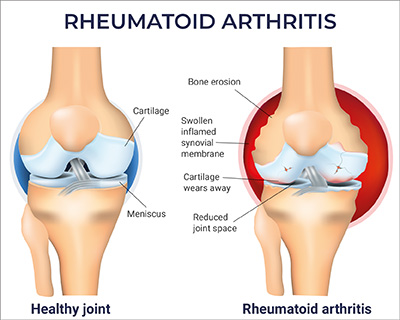
Initially, sufferers usually notice some morning stiffness as well as swelling in small joints (e.g., fingers). The fact that the complaints are strongest in the morning is due, among other things, to a weakness of the adrenal cortex. Actually, it should secrete the anti-inflammatory cortisol at night. If it does not succeed in doing so to a sufficient extent, the inflammations worsen during sleep.
To prevent a rapid worsening of symptoms, affected individuals should seek treatment as early as possible. Vital mushrooms and other natural remedies against rheumatism are an important supplement here. Vital mushrooms such as reishi and cordyceps, for example, can naturally counteract inflammation.
Special forms of arthritis
Here, the symptoms are similar to those of rheumatoid arthritis. However, there is a specific cause for the onset of inflammation or only individual joints are affected.
In psoriatic arthritis, for example, the inflammation of the joints is preceded by the typical symptoms of psoriasis. Psoriasis is itself an autoimmune disease of the skin associated with inflammation. Often only the joints on one side of the body are affected.
Reactive arthritis, in turn, breaks out as a result of an infection that is distant from the joint. Bacterial infections of the respiratory tract, intestines or urinary and genital organs are typical. Arthritis occurs two to four weeks after the infection and usually affects a large, weight-bearing joint (e.g., hip).
Ankylosing spondylitis is a “stiffening inflammation of the vertebrae”. Here, therefore, the vertebral joints, the joints between the ribs and the vertebrae, and between the sacrum and the ilium are primarily affected. Those affected suffer from severe back pain. In the worst case, ossification occurs.
Finally, arthritis can also occur as a result of inflammatory bowel disease.
Collagenoses
These forms of rheumatic disease are relatively rare. All collagenoses have a systemic autoimmune character. In addition to the joints, blood vessels, skin or organs can also be affected by inflammation. Collagenoses include Sjögren’s syndrome, systemic lupus erythematosus, polymyositis, and dermatomyositis.
Carefully selected vital mushrooms such as ABM or Reishi can bring great relief especially in these forms of rheumatism, as they have both an anti-inflammatory and regulating effect on the immune system.
Vasculitis
Here, the blood vessels are primarily inflamed. Circulatory disturbances may occur, as well as leakage of blood and inflammatory cells into surrounding tissues. The consequences are quite different depending on the region or organ. Muscle and joint pain often occur in parallel.
EXPERIENCE REPORTS
"With the help of the medicinal mushrooms I have got my rheumatism under control very well. I've been taking the mushrooms for two years now and I'm really overjoyed that I hardly have any complaints anymore."
EXPERIENCE REPORTS
"The whole joints were affected by rheumatism. After taking the medicinal mushroom shiitake for over a year, she reports to us that her joint pain has improved quite significantly."
Group II: degenerative rheumatic diseases
 The arthroses are assigned to this group. They represent the most common chronic joint disease. The basic problem is always damage to the cartilage, which should actually form a protective layer between the two bones of a joint. If this regresses or even disappears completely, the bones rub against each other, which leads to pain and consequential damage. The cause of wear is usually permanent overload. Also possible are injuries, bacterial infections of the joint or malpositions. When the problems occur as a result of rheumatoid arthritis, physicians refer to it as “secondary osteoarthritis.”
The arthroses are assigned to this group. They represent the most common chronic joint disease. The basic problem is always damage to the cartilage, which should actually form a protective layer between the two bones of a joint. If this regresses or even disappears completely, the bones rub against each other, which leads to pain and consequential damage. The cause of wear is usually permanent overload. Also possible are injuries, bacterial infections of the joint or malpositions. When the problems occur as a result of rheumatoid arthritis, physicians refer to it as “secondary osteoarthritis.”
Osteoarthritis announces itself slowly and is often only noticed at an advanced stage. Typical is the so-called “start-up pain” after periods of rest. Later, the pain of strain is added. Other symptoms include morning stiffness and joint swelling.
Group III: Chronic musculoskeletal pain syndromes & soft tissue rheumatism
This group includes a wide variety of pain syndromes such as chronic back pain, carpal tunnel syndrome and tennis elbow. In soft tissue rheumatism, the soft tissue, bursa, muscles, tendon insertions or even sheaths hurt. The symptoms stem from irritation due to overuse. Muscle tension is considered “localized soft tissue rheumatism.” In this group, for example, the medicinal mushroom Pleurotus natural remedy is used. It has a relaxing effect on the muscles, while relieving inflammation and pain.
This is in contrast to generalized soft tissue rheumatism. It is known by the name fibromyalgia. In this chronic disease, generalized muscle and bone pain is accompanied by fatigue and sleep disturbances.
Group IV: Metabolic disorders with rheumatic complaints
In this last group, problems in metabolism are causative for musculoskeletal pain. In gout, for example, urinary and purine metabolism is disturbed. As a result, uric acid crystals form and are deposited in the joints, among other places. This leads to pain and inflammation. In addition to dietary changes, various vital mushrooms have proven helpful in gout.
 In osteoporosis, in turn, the metabolism in the bones is disturbed. Causes may include inflammatory rheumatism or medication. The bones become porous, which in itself does not cause pain. However, fractures occur frequently as a consequence. Medicinal mushrooms that can support bone formation and thus counteract osteoporosis include cordyceps, maitake and reishi.
In osteoporosis, in turn, the metabolism in the bones is disturbed. Causes may include inflammatory rheumatism or medication. The bones become porous, which in itself does not cause pain. However, fractures occur frequently as a consequence. Medicinal mushrooms that can support bone formation and thus counteract osteoporosis include cordyceps, maitake and reishi.
Who is affected by rheumatism?
It is difficult to put an exact figure on the number of people affected by rheumatism. While osteoarthritis and rheumatoid arthritis are well known today, other rheumatic diseases are so rare that they often take years to diagnose correctly. When making a diagnosis, various criteria such as symptoms and blood values must always be considered together. That this is not always so simple is shown by the so-called rheumatoid factor: although it bears the name of the disease, it is not positive in all sufferers. In healthy individuals, on the other hand, it may well be elevated.
What is certain is that rheumatic complaints are on the rise in Germany. In the meantime, about a quarter of the population suffers at least occasionally from corresponding symptoms. Of these, about half, or about ten million people, are so severe that they (should) undergo treatment. Even among children and adolescents, rheumatism is no exception. It is estimated that around 20,000 minors in Germany suffer from chronic inflammatory rheumatic diseases.
If we look at the prevalence of the individual clinical pictures, osteoarthritis clearly stands out. With five million people affected, it is the most common joint disease in Germany. Older people fall ill more often than young people. From the age of 60, approximately half of all women and one third of all men suffer from the degenerative rheumatic disease. Osteoporosis is also most prevalent among older women: While one in four women over 50 suffers from it, only 6% of men of the same age do. Finally, rheumatoid arthritis occurs three times more frequently in the female sex than in the male sex. According to health insurance data, a total of between 0.6% and 1.4% of the German population suffer from the chronic inflammatory joint disease.
How does rheumatism develop?
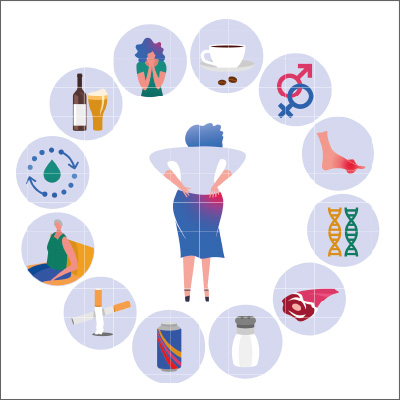 Unfortunately, to date, no clear cause has been identified for any of the rheumatic diseases. Although some disease descriptions, such as reactive arthritis, include an originating factor in the form of an infection, the same infection by no means triggers arthritis in everyone. Researchers therefore now agree that rheumatism is due to an interplay of various factors. In addition to a certain genetic predisposition and hormonal components, lifestyle (exercise, diet, smoking), health problems such as intestinal diseases or infections, and psychological and physical stress also play a role. When choosing natural remedies for rheumatism, these possible causes should always be taken into account.
Unfortunately, to date, no clear cause has been identified for any of the rheumatic diseases. Although some disease descriptions, such as reactive arthritis, include an originating factor in the form of an infection, the same infection by no means triggers arthritis in everyone. Researchers therefore now agree that rheumatism is due to an interplay of various factors. In addition to a certain genetic predisposition and hormonal components, lifestyle (exercise, diet, smoking), health problems such as intestinal diseases or infections, and psychological and physical stress also play a role. When choosing natural remedies for rheumatism, these possible causes should always be taken into account.
Inheritance
“Heredity” means that within a family, the risk of getting the disease is increased. Scientists believe that genetic predisposition accounts for between 50 and 60% of the risk of disease. For example, they have found that individuals with a particular human leukocyte antigen (HLA) gene variant are more likely to develop rheumatoid arthritis than individuals with other variants. Ultimately, however, the final triggers here are also to be found in lifestyle or certain events.
Diseases
Certain infections always occur as triggers for a first rheumatic episode. For example, studies uncovered a link between the Eppstein-Barr virus and the occurrence of rheumatism. Affected persons do not necessarily have to fall ill, but the probability increases. Reiter’s disease is also a typical reactive arthritis that occurs after another infection. Researchers suspect that some pathogens (bacteria, viruses) are very similar to certain structures found in the body. This is why an autoimmune reaction occurs, in which the immune system is directed not only against the pathogen, but also against its own cells. Vital mushrooms can act here as a preventive natural remedy against rheumatism, since some of them have both antiviral or antibacterial and immunomodulating effects.
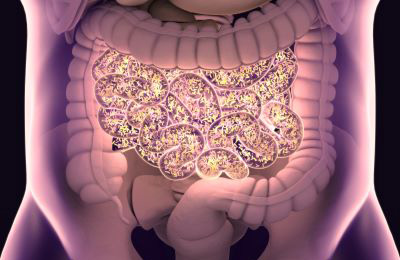 Diseases of the gut such as leaky gut or inflammatory bowel disease pose a high risk of developing autoimmune diseases and chronic inflammatory diseases. The damaged intestinal mucosa then no longer functions as a protective barrier. It allows more inflammation-promoting proteins as well as bacterial toxins or components to pass through. As a consequence, inflammation can occur in various parts of the body. In addition, the immune system is strongly challenged to fight off the invading substances. This again sets autoimmune processes in motion. Vital mushrooms have something to counter this. They are rich in ingredients that promote healthy intestinal flora. Hericium also has a regenerating effect on the intestinal mucosa, which makes it the medicinal mushroom of choice for Leaky gut.
Diseases of the gut such as leaky gut or inflammatory bowel disease pose a high risk of developing autoimmune diseases and chronic inflammatory diseases. The damaged intestinal mucosa then no longer functions as a protective barrier. It allows more inflammation-promoting proteins as well as bacterial toxins or components to pass through. As a consequence, inflammation can occur in various parts of the body. In addition, the immune system is strongly challenged to fight off the invading substances. This again sets autoimmune processes in motion. Vital mushrooms have something to counter this. They are rich in ingredients that promote healthy intestinal flora. Hericium also has a regenerating effect on the intestinal mucosa, which makes it the medicinal mushroom of choice for Leaky gut.
Lifestyle
Nutrition and stress are also involved in damage to the intestinal environment and the intestinal mucosa. Rheumatologists blame an increasing, generally poor diet for the increased incidence of rheumatic diseases. In particular, the lack of dietary fiber in our foods leads to a lack of diversity in the intestinal flora. Often, the bacteria that produce inflammation-regulating short-chain fatty acids or keep the intestinal mucosa healthy are particularly lacking. Bacteria containing lipopolysaccharide LPS can proliferate, especially after high-fat meals. This pro-inflammatory substance can be found in the blood a short time later, this is often observed in psoriasis patients.
 In addition to foods low in fiber, those of animal origin are also unfavorable for our health. This is because they contain pro-inflammatory acids such as arachidonic and sialic acid. The prevalence of obesity is also a risk factor for rheumatism. For example, people with an elevated body mass index (BMI) have a greater likelihood of developing the disease. The reason for this could be adipokines, especially leptin, which is produced in large quantities in people with a lot of fatty tissue. In addition, a high weight is always a strain on the joints, which favors osteoarthritis. Another risk factor is abdominal fat. It is so dangerous because it produces pro-inflammatory messenger substances.
In addition to foods low in fiber, those of animal origin are also unfavorable for our health. This is because they contain pro-inflammatory acids such as arachidonic and sialic acid. The prevalence of obesity is also a risk factor for rheumatism. For example, people with an elevated body mass index (BMI) have a greater likelihood of developing the disease. The reason for this could be adipokines, especially leptin, which is produced in large quantities in people with a lot of fatty tissue. In addition, a high weight is always a strain on the joints, which favors osteoarthritis. Another risk factor is abdominal fat. It is so dangerous because it produces pro-inflammatory messenger substances.
Finally, tobacco use is a major factor that may play a role in both the development and worsening of rheumatic diseases. As a result of smoking, some proteins in the body appear to change shape. The immune system then perceives them as invaders and begins to attack them. These autoimmune processes can eventually affect the musculoskeletal system.
Why are women more often affected?
 When we look at the causes of rheumatism, the question of why women suffer from some rheumatic diseases so much more frequently than men suggests itself. There are also various theories on this, which have not yet been conclusively proven. One of these is based on the finding that women are more likely to get urinary tract infections than men. As mentioned above, rheumatism can develop in response to such an infection. That is why this reactive form inevitably occurs more frequently in women.
When we look at the causes of rheumatism, the question of why women suffer from some rheumatic diseases so much more frequently than men suggests itself. There are also various theories on this, which have not yet been conclusively proven. One of these is based on the finding that women are more likely to get urinary tract infections than men. As mentioned above, rheumatism can develop in response to such an infection. That is why this reactive form inevitably occurs more frequently in women.
Another hypothesis relates to gender specificity: women generally have better defenses, but are also more likely to develop inflammation and autoimmune diseases than men.
Finally, hormones themselves may play a regulatory role in the onset of rheumatic diseases. Exactly what this looks like and the mechanisms behind it are largely unclear. But in practice, for example, it has been shown that women who take the contraceptive pill have a lower risk of developing rheumatism. A deficiency of more anti-inflammatory progesterone is also discussed.
What helps with rheumatism?
 Unfortunately, all rheumatic diseases cannot be cured; the predisposition to them usually remains. However, many of them occur in relapses, and those affected can certainly influence the strength and length of the relapses. Thus, there are various natural remedies for rheumatism that alleviate the discomfort during an episode and prolong the symptom-free or even asymptomatic phases. There are even reports of rheumatism patients who have achieved permanent remission. In any case, it is important to detect the disease early and start treatment immediately.
Unfortunately, all rheumatic diseases cannot be cured; the predisposition to them usually remains. However, many of them occur in relapses, and those affected can certainly influence the strength and length of the relapses. Thus, there are various natural remedies for rheumatism that alleviate the discomfort during an episode and prolong the symptom-free or even asymptomatic phases. There are even reports of rheumatism patients who have achieved permanent remission. In any case, it is important to detect the disease early and start treatment immediately.
Nowadays, therapies are precisely tailored to the individual case. As the person affected, you naturally have the scepter in your hand and can try out various measures. What works for one person does not necessarily help another. In the field of natural remedies, for example, the following options are available:
- Mycotherapy
- Phytotherapy
- Intestinal rehabilitation: Here, the vital mushrooms Hericium, Pleurotus and Reishi can support.
- Dietary change: The goal should be a whole-food diet that is low in fat and high in fiber and low in animal products. Various studies show that a vegan or vegetarian diet significantly alleviates rheumatism symptoms.
- In case of overweight, weight reduction should be aimed for.
- Orthomolecular therapy: Here, nutrients of which there is a deficiency are specifically supplied. Some nutrients, such as vitamin D, magnesium, folic acid, selenium, zinc, copper, coenyzm Q10, and omega-3 fatty acids, are quickly depleted by persistent smoldering inflammation in the body.
- Homeopathy
- Turmeric and frankincense are considered anti-inflammatories.
- Dry cold relieves pain and swelling.
- Exercise is an essential measure that should always be included. It counteracts inflammation and at the same time improves metabolism.
Which vital mushrooms help with rheumatism?
Vital or medicinal mushrooms are used within the framework of mycotherapy. We have already touched on various properties that address causes or alleviate symptoms depending on the rheumatic disease. The following properties of vital mushrooms are central in their use as a natural remedy for rheumatism:
- Many medicinal mushrooms are “immune modulators”. This means that they not only strengthen the immune system, but also regulate excessive reactions. This speaks for their use in autoimmune diseases.
- Medicinal mushrooms have anti-inflammatory and antioxidant effects. The reasons for this include the triterpenes, polyphenols and polysaccharides they contain.
- Taking medicinal mushrooms can improve the intestinal flora and mucous membrane.
- The ingredients of medicinal mushrooms support the metabolism in various ways. Those who are overweight can use medicinal mushrooms to help them lose weight. Those who suffer from high blood lipid levels or even fatty liver turn to vital mushrooms, which lower cholesterol and triglyceride levels.
- Some medicinal mushrooms increase the resistance and stress resistance of the human organism. This helps with frequent infections or also complaints as a result of great stress.
- Some medicinal mushrooms even contain substances that relieve pain.
Now we would like to introduce you to the vital mushrooms that are recommended as natural remedies for rheumatism. Get a first impression of what mushrooms there are and how they work. For a targeted selection that will provide you with optimal help for your individual problem, please consult our experts.
Reishi
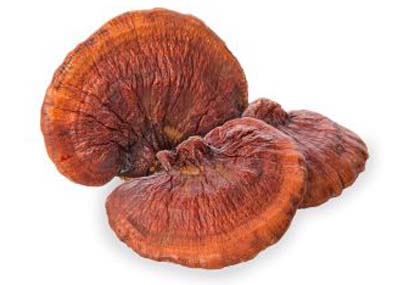 The Reishi is a very good natural remedy for rheumatism and has already helped many sick people to a better quality of life. This is due, on the one hand, to the fact that it exerts a positive influence on the intestinal flora. It promotes balanced intestinal flora, healthy intestinal mucosa and its ingredients interact with the intestinal immune system. Since it also contains anti-inflammatory substances, it is also the remedy of choice for inflammatory bowel diseases, leaky gut and irritable bowel syndrome. Its intake can alleviate LPS (lipopolysacchride)-related inflammation in particular.
The Reishi is a very good natural remedy for rheumatism and has already helped many sick people to a better quality of life. This is due, on the one hand, to the fact that it exerts a positive influence on the intestinal flora. It promotes balanced intestinal flora, healthy intestinal mucosa and its ingredients interact with the intestinal immune system. Since it also contains anti-inflammatory substances, it is also the remedy of choice for inflammatory bowel diseases, leaky gut and irritable bowel syndrome. Its intake can alleviate LPS (lipopolysacchride)-related inflammation in particular.
This vital mushroom also has a positive influence on blood lipid levels. Those who are already overweight and suffer from elevated cholesterol levels benefit from the cholesterol-lowering effects of triterpenes such as ganoderic acids from reishi, which can also prevent fatty liver. About the intestinal flora, it can facilitate weight loss. In the end, with regard to destructive osteoarthritis processes, its antioxidant and pain-reducing effects are especially important. In addition, joints must of course be relieved by correcting incorrect posture or pressure.
Not to be despised is the balancing and calming effect of the reishi. This prevents stress-related aggravations and symptoms such as muscular tension. It promotes healthy sleep and thus provides the organism with the necessary rest to regenerate and heal itself.
The immune system also benefits from the intake of this vital mushroom: Thus, it strengthens the defenses, but equally has a modulating effect, if it comes to excessive, autoimmune reactions. Certain ingredients also have an antiviral effect. This means that on the one hand they make it more difficult for certain pathogens to penetrate the organism, and on the other hand they inhibit their spread in the body. Thus, rheumatic attacks in response to an infection become less likely.
Cordyceps
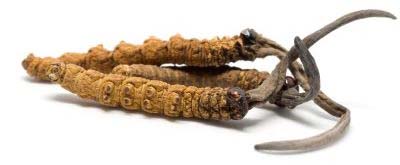 Cordyceps contains a very special substance: cordycepin. It is extremely valuable for people with rheumatism. For example, it regulates excessive cytokine release and thus prevents the dangerous cytokine storms. Inflammation is contained. Researchers also consider cordycepin’s antibiotic, anti-inflammatory, and analgesic properties to be paramount. Cordyceps is commonly used traditionally against infections and to support healthy defenses, and thus can reduce the risk of infections, which in turn can trigger flare-ups. More generally, Cordyceps supports the immune system and is also used against resistant germs or a candida problem.
Cordyceps contains a very special substance: cordycepin. It is extremely valuable for people with rheumatism. For example, it regulates excessive cytokine release and thus prevents the dangerous cytokine storms. Inflammation is contained. Researchers also consider cordycepin’s antibiotic, anti-inflammatory, and analgesic properties to be paramount. Cordyceps is commonly used traditionally against infections and to support healthy defenses, and thus can reduce the risk of infections, which in turn can trigger flare-ups. More generally, Cordyceps supports the immune system and is also used against resistant germs or a candida problem.
Cordyceps is also involved in protecting the kidneys and adrenal glands, which can be damaged by medication. The adrenal glands are so important in inflammatory rheumatic diseases because this is where the anti-inflammatory cortisol is produced. Overall, cordyceps has a regulating effect on hormone production of the adrenal glands, thyroid gland and the entire endocrine system. This can be particularly beneficial for women, who may also be more susceptible to various rheumatic diseases due to their hormonal situation.
Hericium
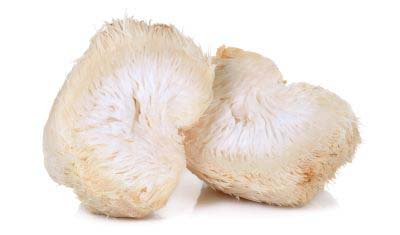 Mycotherapists have been successfully using Hericium for a long time for intestinal diseases. Due to its prebiotic properties, it strengthens a healthy environment and regulates bacterial diversity. Almost more important, however, is its ability to protect and regenerate the intestinal mucosa. Thus, it is the drug of choice for leaky gut and chronic inflammatory bowel disease. A diseased intestine always carries the risk of autoimmune diseases such as rheumatoid arthritis. The healthier the intestinal flora and mucosa, the stronger the immune system. Hericium also supports the immune system by activating natural killer cells, mucosal immunity or phagocytosis. In an application observation with Hericium mushroom powder the uric acid, the LDL cholesterol and the creatinine could be lowered with the test persons, one assumes over the changed intestinal flora, which has large influence on our metabolism and is nourish-dependent.
Mycotherapists have been successfully using Hericium for a long time for intestinal diseases. Due to its prebiotic properties, it strengthens a healthy environment and regulates bacterial diversity. Almost more important, however, is its ability to protect and regenerate the intestinal mucosa. Thus, it is the drug of choice for leaky gut and chronic inflammatory bowel disease. A diseased intestine always carries the risk of autoimmune diseases such as rheumatoid arthritis. The healthier the intestinal flora and mucosa, the stronger the immune system. Hericium also supports the immune system by activating natural killer cells, mucosal immunity or phagocytosis. In an application observation with Hericium mushroom powder the uric acid, the LDL cholesterol and the creatinine could be lowered with the test persons, one assumes over the changed intestinal flora, which has large influence on our metabolism and is nourish-dependent.
In addition, the vital mushroom Hericium is able to buffer the effects of stress on our organism. It has a calming effect and prevents sleep disorders. In some rheumatic diseases, a worsening or the beginning of a new relapse can be observed under the influence of stress. Here the Hericium can be taken preventively.
If an inflammatory rheumatic disease is already present, possible consequential damage in all areas of the body should be kept in mind. Hericium is able to counteract negative consequences at the level of the nerves. By stimulating nerve growth factor, it promotes and protects the regeneration of nerves. It also has a beneficial effect on the formation of the myelin sheaths surrounding the nerves. These are often damaged during inflammation in the body.
Shiitake
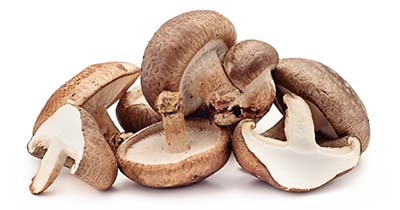 Like all vital mushrooms, shiitake exerts a beneficial influence on the intestinal flora. People affected by rheumatism or osteoarthritis repeatedly report that the health of their joints has improved significantly thanks to the intake of shiitake. In osteoarthritis and arthritis, especially its immunomodulating properties bring relief.
Like all vital mushrooms, shiitake exerts a beneficial influence on the intestinal flora. People affected by rheumatism or osteoarthritis repeatedly report that the health of their joints has improved significantly thanks to the intake of shiitake. In osteoarthritis and arthritis, especially its immunomodulating properties bring relief.
Results from various studies indicate that taking shiitake improves subjects’ immune and inflammatory levels. Researchers blame this on several ingredients, such as lentinan, other polysaccharides, ergosterol, and lenthionine. They all activate various immune mechanisms and promote the formation of certain immune cells. They also regulate certain messenger substances in the body that are associated with the development and maintenance of inflammation.
Agaricus blazei murill
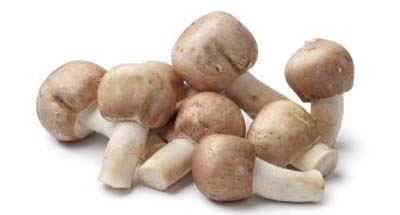 The ABM or almond mushroom is a relative of the mushroom and originates from South America, but is now cultivated worldwide. It is a vital mushroom that can be used for all autoimmune diseases. It has particularly complex beta-glucans and, along with Reishi, is considered one of the most powerful immune modulators. Regarding autoimmune diseases such as MS, fibromyalgia or rheumatism, it is considered anti-inflammatory and immune balancing.
The ABM or almond mushroom is a relative of the mushroom and originates from South America, but is now cultivated worldwide. It is a vital mushroom that can be used for all autoimmune diseases. It has particularly complex beta-glucans and, along with Reishi, is considered one of the most powerful immune modulators. Regarding autoimmune diseases such as MS, fibromyalgia or rheumatism, it is considered anti-inflammatory and immune balancing.
It has both antiviral and antibacterial properties, activates Natural Killer Cells, and is often used in complementary cancer therapy.
In an animal experiment, he was able to successfully reduce inflammatory processes provoked by a high-fat diet by reducing inflammatory messenger substances. Therefore, a low-fat diet is also more recommended for autoimmune diseases. It also has an inhibitory effect on uric acid production via xanthine oxidase.
Its liver-protective properties have traditionally been used against hepatitis, and recent studies have shown that it may also protect the liver against necrotic cell death. Something similar has been shown for nerve cells. In addition to its anti-inflammatory properties, its pain-reducing properties make it an important “basic fungus” for rheumatic diseases.
Maitake
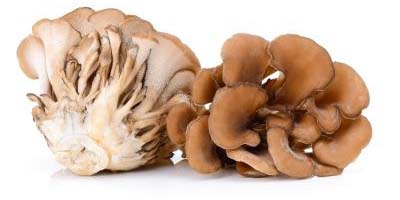 Intestinal health can also improve by taking the vital mushroom maitake. Since inflammations often decrease at the same time, people with chronic inflammatory bowel diseases, diarrhea or irritable bowel syndrome in particular benefit from this. In general, maitake can provide relief to individuals with inflammatory types of rheumatism.
Intestinal health can also improve by taking the vital mushroom maitake. Since inflammations often decrease at the same time, people with chronic inflammatory bowel diseases, diarrhea or irritable bowel syndrome in particular benefit from this. In general, maitake can provide relief to individuals with inflammatory types of rheumatism.
Mycotherapists also use this vital mushroom for people suffering from osteoporosis. By stimulating the activity of bone-forming osteoblasts, bone stability may improve or decrease more slowly.
The positive effect of the Maitake medicinal mushroom on the uric acid level should be particularly emphasized. Thanks to its ingredients, which inhibit the reabsorption of uric acid via the transporter URAT1, the risk of painful gout attacks decreases. In addition, excessive fructose uptake into the liver is impeded, which on the one hand makes the formation of a fatty liver more difficult and on the other hand can again reduce excessive uric acid increases.
Where can I buy vital mushrooms against rheumatic diseases?
Researchers have now published many interesting facts about the health effects of medicinal mushrooms. Even though traditional Chinese medicine in particular has been using it for centuries as a natural remedy for rheumatism, the hard facts are always decisive for its acceptance in the Western world. With the evidence for the effect of vital mushrooms, the providers of the same also shoot up like mushrooms. Now, when you start looking, you should pay attention to the following quality criteria:
1. cultivation according to German organic guidelines: Since mushrooms absorb pollutants from their environment very easily, they should grow in as natural an environment as possible. Substances harmful to health from substrate or pesticides would otherwise end up directly with you as the end consumer.
2. gentle processing into powder: Mushroom powder has proven itself many times as a dosage form. However, the drying as well as the grinding of the vital mushrooms must be done gently. Only if the mushroom is consistently processed below 40 degrees Celsius, all substances important for health are preserved. Finally, the powder is best preserved in capsules, as these keep moisture out and thus prevent mold growth.
3. powder from the whole mushroom: not every substance relevant to health is found equally in all parts of the mushroom. That is why the whole mushroom must always be processed into powder.
At the end of the day, there is no standard vital mushroom that will help every person suffering from rheumatism in a certain dosage. Therefore, it is always important to have extensive, individual advice before making a purchase. Here, the entire life situation as well as other health problems are taken into account. For a detailed discussion, please contact our experts, who have many years of experience with vital mushrooms.
DO YOU HAVE ANY QUESTIONS?
We will gladly take time for you. In our free consultation we answer individually and personally all your health questions under:
Scientific studies / sources:
- Thews, Mutschler, Vaupel: “Anatomy, Physiology, Pathophysiology of Man”; Wissenschaftliche Verlagsgesellschaft mbH Stuttgart 1999
- Uwe Karstädt: “The 7 Revolutions of Medicine”; Rowohlt Verlag 2006
- Stavinoha, W., Satsangi, N., Weintraub, S.(1995): “Study of the anti-inflammatory efficacy of Ganoderma lucidum” In B.-K. Kim, & Y.-S. Kim (Eds ), Recent Advances in Ganoderma lucidum research (pp 3-7) Seoul, Korea: The Pharmaceutical Society of Korea.
- Tavinoha, W., Slama, J., Weintraub, S., Mobley, P. (1991): “The Anti-inflammatory activity of Ganoderma lucidum”; Third International Symposium on Ganoderma lucidum, 9-21.
- C. Gominak, Vitamin D deficiency changes the intestinal microbiome reducing B vitamin production in the gut. The resulting lack of pantothenic acid adversely affects the immune system, producing a “pro-inflammatory” state associated with atherosclerosis and autoimmunity, Medical Hypotheses, Volume 94, 2016, Pages 103-107, ISSN 0306-9877.
- Mehwish MA et al, Therapeutic Value of Medicinal Mushroom.
Agaricus blazei Murill, https://pjmd.zu.edu.pk/wp-content/uploads/2021/02/PJMD-10.1-Final.pdf#page=88 - Xie, X.-Q.; Geng, Y.; Guan, Q.; Ren, Y.; Guo, L.; Lv, Q.; Lu, Z.-M.; Shi, J.-S.; Xu, Z.-H. Influence of Short-Term Consumption of Hericium erinaceus on Serum Biochemical Markers and the Changes of the Gut Microbiota: A Pilot Study. Nutrients 2021, 13, 1008. https://doi.org/10.3390/nu13031008
